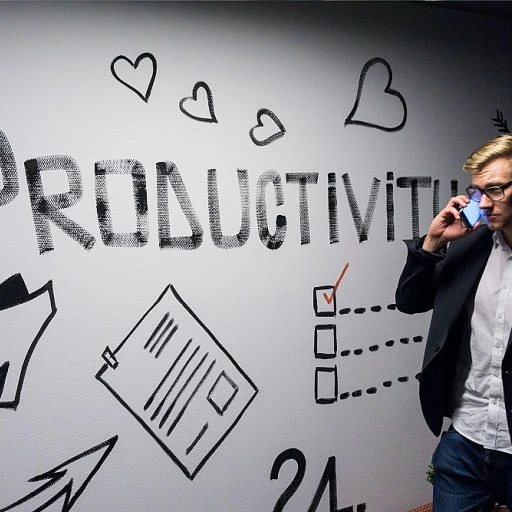Understanding the Importance of Employee Retention
The Significance of Retaining Talent
In today's competitive job market, understanding the importance of employee retention is crucial for any organization aiming for long-term success. Retaining top talent not only saves on the costs associated with hiring and training new staff but also ensures continuity and stability within the company. High turnover rates can disrupt business operations, affect morale, and ultimately impact the bottom line.
Employee retention is not just about keeping employees on the payroll; it involves creating an environment where professionals feel valued and motivated to contribute to the organization's goals. This is where effective human resources staffing plays a pivotal role. By implementing strategic staffing solutions, companies can better manage their personnel services and foster a culture of loyalty and engagement.
Why Retention Matters in Business Strategy
For businesses, retaining employees means maintaining a competitive edge. When staff find satisfaction in their jobs, they are more likely to stay, reducing the need for constant recruitment and the reliance on staffing agencies. This stability allows companies to focus on growth and innovation rather than continuously searching for new candidates.
Moreover, a strong retention strategy enhances the company's reputation as a desirable place to work, attracting top talent and making the recruitment process more efficient. Organizations that prioritize employee retention are often seen as leaders in their industries, setting the standard for others to follow.
For more insights into how contingent job offers can impact employee retention, explore this understanding of the impact.
The Role of Human Resources in Retention
The Integral Role of Human Resources Professionals
Human resources (HR) professionals play a crucial role in fostering employee retention within companies. An effective HR team implements strategic recruitment processes tailored to attract top talent and retain them for the long term. They work closely with hiring managers to ensure that every aspect of the recruitment process, from job posting to final hire, is optimized for success. Effective HR teams prioritize talent acquisition by utilizing a variety of staffing solutions. They collaborate with staffing agencies, leveraging their specialized recruitment services to find the ideal candidates for various job roles. By doing so, they not only streamline the process of finding the right fit but also enhance the overall candidate experience, ultimately contributing to higher retention rates.Navigating Retention Challenges with HR Expertise
Identifying and addressing retention challenges is another vital responsibility of HR. Professionals in this field must stay abreast of the ever-evolving job market and adapt strategies to meet the needs of both businesses and employees. Understanding and addressing these challenges is a critical step toward maintaining a stable workforce. HR can tackle these issues by offering competitive compensation packages, fostering growth opportunities, and ensuring cultural alignment within the organization. Moreover, HR professionals should work on developing effective employee retention policies to further bolster their strategies. For more insights, consider crafting effective employee retention policies.Optimizing Staffing for Retention
Strategic staffing is yet another area where resource staffing efforts by HR can make a monumental difference. Whether it’s through direct hire processes or temporary staffing options, HR’s role in identifying and aligning talent with the company’s objectives is critical. Staffing agencies are invaluable to human resources when it comes to the recruitment process. These agencies provide access to a broad range of job seekers, allowing HR teams to refine their search and identify the most suitable personnel. The right agency can help organizations navigate a competitive job market, ensuring they remain an employer of choice by not only hiring effectively but also retaining valuable employees. Efficient HR teams continually refine their staffing solutions to adapt to industry trends and organizational growth. They balance external recruitment with internal promotions, ensuring they preserve and enhance corporate culture.Identifying Key Retention Challenges
Challenges Beyond Staffing Solutions
Tackling employee retention goes beyond merely staffing solutions; it's essential to recognize the multifaceted challenges that organizations face. Perhaps one of the most pervasive issues is maintaining an engaging work culture that supports both personal and professional growth. This involves addressing the needs of diverse employees and ensuring they feel valued in the workplace.
Misalignment in Talent Acquisition
Covering positions with the right talent is crucial, but even with effective staffing agency partnerships, it's not always straightforward. Companies might struggle with aligning candidate skills to specific job roles, leading to turnover and dissatisfaction. To avoid this, businesses need to focus on tailoring their human resources approaches to better match job seekers with suitable roles. This can significantly improve retention and job satisfaction.
Competing in the Job Market
The current job market is ever-competitive, with employees constantly evaluating their options. Companies must adopt innovative recruitment processes to ensure they attract top talent. This includes effectively using staffing recruiting services and even considering temp hire solutions to maintain flexibility. However, retaining these professionals is often a hurdle as competitors might offer better incentives or a more appealing company culture.
Employee Development as a Retention Tool
A key challenge in retention is providing employees with opportunities for career advancement and continuous learning. Organizations that do not implement robust development programs might find their staff looking for better opportunities elsewhere. Direct hire and temp agency initiatives should incorporate comprehensive development tracks to ensure long-term engagement and fulfillment among employees.
Strategies for Effective Staffing
Strategic Staffing for Retention Success
Effective staffing is a cornerstone of successful employee retention. By aligning your human resources strategies with your business goals, you can ensure that your organization attracts and retains top talent. Here are some strategies to enhance your staffing efforts:
- Utilize Staffing Agencies: Partnering with a staffing agency can help you find qualified candidates quickly. These agencies have access to a vast pool of job seekers and can provide staffing solutions tailored to your needs.
- Focus on Talent Acquisition: Develop a robust talent acquisition strategy that goes beyond filling immediate jobs. Aim to hire individuals who align with your company culture and long-term goals.
- Enhance Recruitment Processes: Streamline your recruitment process to make it efficient and candidate-friendly. This can include clear job descriptions, prompt communication, and a smooth interview process.
- Leverage Human Resources Expertise: Your human resources team plays a crucial role in retention. Equip them with the tools and training needed to identify and nurture potential employees.
- Consider Temp and Direct Hire Options: Depending on your organizational needs, a mix of temp hire and direct hire strategies can provide flexibility and stability.
By implementing these strategies, your organization can build a strong workforce that is both skilled and committed. Remember, effective staffing is not just about filling positions; it's about creating a sustainable environment where employees can thrive and contribute to the organization's success.
Creating a Supportive Work Environment
Fostering a Positive Workplace Culture
Creating a supportive work environment is crucial for enhancing employee retention. A positive workplace culture not only attracts top talent but also keeps current employees engaged and motivated. Human resources professionals play a pivotal role in shaping this culture by implementing policies that promote inclusivity, respect, and open communication.
Encouraging Professional Development
Providing opportunities for professional growth is essential in retaining employees. Organizations can achieve this by offering training programs, mentorship opportunities, and career advancement paths. By investing in the development of their staff, companies demonstrate their commitment to the long-term success of their employees, which can significantly reduce turnover rates.
Balancing Work and Life
Today's job market demands flexibility. Employees value work-life balance, and companies that recognize this need often see higher retention rates. Human resources can implement flexible working arrangements, such as remote work options or flexible hours, to accommodate the diverse needs of their workforce.
Recognizing and Rewarding Contributions
Recognition and rewards are powerful tools in employee retention. Regularly acknowledging the hard work and achievements of employees can boost morale and reinforce loyalty. Whether through formal recognition programs or simple gestures of appreciation, showing employees that their efforts are valued can make a significant difference.
Building Strong Relationships
Strong interpersonal relationships within the workplace contribute to a supportive environment. Encouraging collaboration and teamwork, as well as providing opportunities for social interactions, can help build a sense of community. This sense of belonging can be a deciding factor for employees when considering their long-term commitment to a company.
Measuring Success in Retention Efforts
Assessing Retention Metrics
To ensure the success of your retention initiatives, it’s crucial to assess various metrics systematically. Effective evaluation involves gathering and analyzing data to identify both strengths and areas for improvement. This process allows human resources to adjust strategies and eliminate inefficiencies.- Turnover Rates: Regularly tracking turnover rates helps in understanding the frequency and reasons for employee exits. This data provides insights into the business’s stability and the effectiveness of staffing practices.
- Exit Interviews: Conducting structured exit interviews can reveal why employees leave and what could have been done differently. These interviews offer firsthand accounts of personnel experiences and highlight potential areas for human resource improvement.
- Employee Surveys: Utilizing anonymous surveys aids in acquiring genuine feedback regarding the workplace environment, staffing solutions, and job satisfaction. Surveys assess employee sentiments about workplace support and resource availability.
- Performance and Engagement Metrics: Monitoring employee performance and engagement levels indicates the level of motivation and job satisfaction in your organization. High engagement correlates with higher retention rates, reflecting successful human resources efforts.
Adapting to Trends in Talent Acquisition
Ongoing adaptation to shifts in the job market is essential for long-term retention. By observing trends, staffing solutions can be tailored to attract top talent more successfully, aligning with current professional expectations and needs.- Leverage Staffing Agencies: Collaborating with staffing agencies can streamline hiring processes and enhance candidate quality through comprehensive searches. Agencies possess resourceful insights into finding ideal candidates for both direct and temp hire needs.
- Embrace Flexible Hiring Practices: Adapting to candidates’ desires for flexibility, particularly in recruiting professionals for remote or hybrid positions, broadens your potential talent pool. Such shifts can account for diverse workforce retention.








